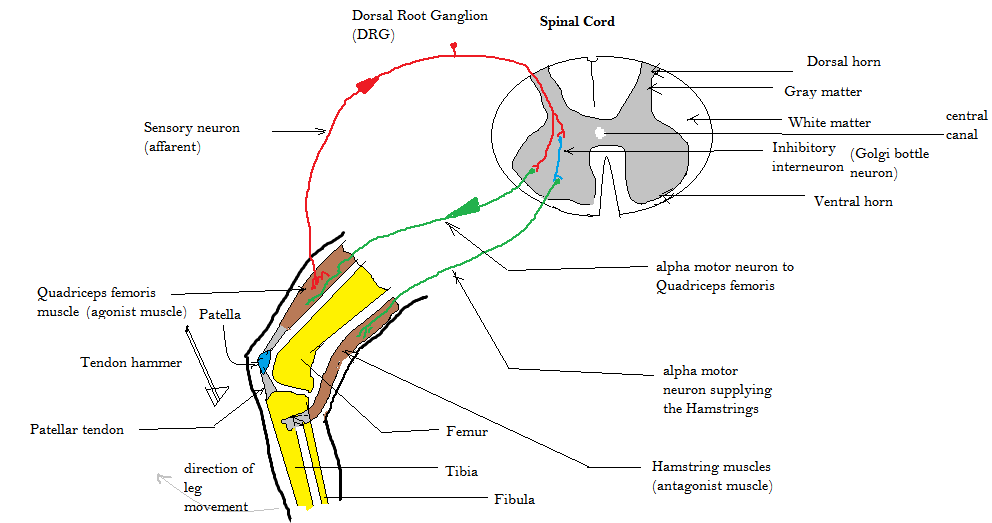Proprioception: Balance and Phantom Limbs
23 Kinesthesia and Proprioception
Learning Objectives
Understand the relationship between the terms kinesthesia and proprioception.
Be able to explain how the knee-jerk reflex works.
Proprioception is the sense of the relative positioning of neighboring parts of the body, and the sense of the strength of effort needed for movement. It is distinguished from exteroception, by which one perceives the outside world, and interoception, by which one perceives pain, hunger, and the movement of internal organs. A major component of proprioception is joint position sense (JPS), which involves an individual’s ability to perceive the position of a joint without the aid of vision. Proprioception is one of the subtler sensory systems, but it comes into play almost every moment. This system is activated when you step off a curb and know where to put your foot, or when you push an elevator button and control how hard you have to press down with your fingers.
Kinesthesia is the awareness of the position and movement of the parts of the body using sensory organs, which are known as proprioceptors, in joints and muscles. Kinesthesia is a key component in muscle memory and hand-eye coordination. The discovery of kinesthesia served as a precursor to the study of proprioception. While the terms proprioception and kinesthesia are often used interchangeably, they actually have many different components. Often the kinesthetic sense is differentiated from proprioception by excluding the sense of equilibrium or balance from kinesthesia. An inner ear infection, for example, might degrade the sense of balance. This would degrade the proprioceptive sense, but not the kinesthetic sense. The affected individual would be able to walk, but only by using the sense of sight to maintain balance; the person would be unable to walk with eyes closed. Another difference in proprioception and kinesthesia is that kinesthesia focuses on the body’s motion or movements, while proprioception focuses more on the body’s awareness of its movements and behaviors. This has led to the notion that kinesthesia is more behavioral, and proprioception is more cognitive.
Reflexes combine the spinal sensory and motor components with a sensory input that directly generates a motor response. The reflexes that are tested in the neurological exam are classified into two groups. A deep tendon reflex is commonly known as a stretch reflex and is elicited by a strong tap to a tendon, such as in the knee-jerk reflex. A superficial reflex is elicited through gentle stimulation of the skin and causes contraction of the associated muscles.

Knee-jerk reflex, also called patellar reflex, is a sudden kicking movement of the lower leg in response to a sharp tap on the patellar tendon, which lies just below the kneecap (Fig.3.1.1). One of the several positions that a subject may take for the test is to sit with knees bent and with one leg crossed over the other so that the upper foot hangs clear of the floor. The sharp tap on the tendon slightly stretches the quadriceps, the complex of muscles at the front of the upper leg. In reaction, these muscles contract and the contraction tends to straighten the leg in a kicking motion. Exaggeration or absence of the reaction suggests that there may be damage to the central nervous system. The knee jerk can also be helpful in recognizing thyroid disease.
| Glossary | Examples | |
| Proprioception |
|
|
| Kinesthesia |
|
|
Difference between kinesthesia and Proprioception:
- Kinesthesia excludes the sense of equilibrium or balance.
- Kinesthesia focuses on the body’s awareness of its motions or movements.
Example: Inner ear infection degrading sense of balance would degrade the proprioceptive sense, but not the kinesthetic sense.
- Affected individual would be able to walk, but only by using the sense of sight to maintain balance
- Would be unable to walk with eyes closed
If you want to learn more about reflexes, watch this youtube video or follow this link to OpenStax Textbook chapter on Sensory and Motor Exams.
Exercises
Reflection
Take a minute to answer these questions in your notes:
- In a few sentences, describe the relationship between the terms kinesthesia and proprioception.
- In a few sentences, please explain how the knee-jerk reflex works.
CC LICENSED CONTENT, SHARED PREVIOUSLY
Lumen Learning, Boundless Psychology, Sensory Processes
Provided by: Boundless.com.
URL: https://courses.lumenlearning.com/boundless-psychology/chapter/sensory-processes/
License: CC-BY-SA
OpenStax, Anatomy and Physiology Chapter 16.4 The Sensory and Motor Exams
Provided by: Rice University.
Access for free at https://openstax.org/books/anatomy-and-physiology/pages/1-introduction
License: CC BY 4.0
Encyclopaedia Britannica, Knee-Jerk Reflex
URL: https://www.britannica.com/science/knee-jerk-reflex
License: CC BY-NC 3.0 US

